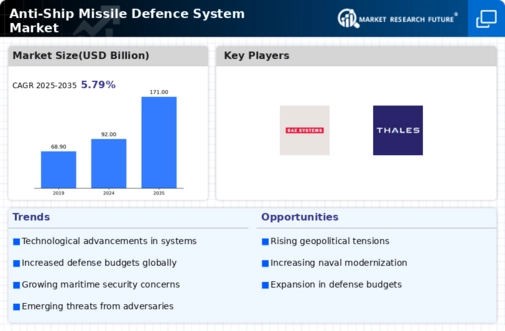North America : Defense Innovation Leader
North America is the largest market for Anti-Ship Missile Defence Systems, holding approximately 45% of the global market share. The region's growth is driven by increasing defense budgets, technological advancements, and geopolitical tensions. The U.S. government has been actively investing in missile defense technologies, which further fuels demand. Regulatory support and partnerships with defense contractors also play a crucial role in market expansion.
The United States is the leading country in this sector, with major players like Lockheed Martin, Raytheon Technologies, and Northrop Grumman dominating the landscape. These companies are at the forefront of innovation, developing advanced systems to counter emerging threats. The competitive environment is characterized by significant R&D investments and collaborations with government agencies, ensuring a robust defense posture against maritime threats.
Europe : Strategic Defense Collaborations
Europe is witnessing a significant rise in demand for Anti-Ship Missile Defence Systems, holding around 30% of the global market share. The region's growth is propelled by increasing naval capabilities and collaborative defense initiatives among EU nations. Regulatory frameworks are evolving to enhance interoperability and joint operations, which are critical for addressing maritime security challenges. Countries are also focusing on modernizing their fleets, further driving market demand.
Key players in Europe include Thales Group, BAE Systems, and MBDA, which are actively engaged in developing cutting-edge missile defense technologies. The competitive landscape is marked by strategic partnerships and joint ventures aimed at enhancing defense capabilities. Countries like France, the UK, and Italy are leading the charge, investing heavily in R&D to ensure they remain at the forefront of naval defense technology.
Asia-Pacific : Emerging Defense Market
Asia-Pacific is emerging as a significant market for Anti-Ship Missile Defence Systems, accounting for approximately 20% of the global market share. The region's growth is driven by rising military expenditures, territorial disputes, and the need for enhanced maritime security. Countries are increasingly investing in advanced defense technologies, supported by favorable government policies and international collaborations, which are crucial for regional stability and security.
Leading countries in this region include India, Japan, and Australia, with key players like Hindustan Aeronautics Limited and Kongsberg Gruppen making substantial contributions. The competitive landscape is characterized by a mix of domestic and international firms, all vying for a share of the growing market. The focus on indigenous defense production and technology transfer is also shaping the market dynamics, ensuring that countries can meet their defense needs effectively.
Middle East and Africa : Strategic Defense Investments
The Middle East and Africa region is increasingly recognizing the importance of Anti-Ship Missile Defence Systems, holding about 5% of the global market share. The growth is driven by rising geopolitical tensions, particularly in the Gulf region, and the need for enhanced maritime security. Governments are prioritizing defense spending to modernize their naval capabilities, supported by international partnerships and arms procurement strategies that align with regional security objectives.
Countries like Saudi Arabia, the UAE, and South Africa are leading the charge in defense investments, with a focus on acquiring advanced missile defense systems. The competitive landscape features both local and international players, with firms like Rafael Advanced Defense Systems and Leonardo actively participating in the market. The emphasis on technology transfer and local production is shaping the future of defense capabilities in the region, ensuring that nations can effectively address maritime threats.


















Leave a Comment